Lessico
Vischio
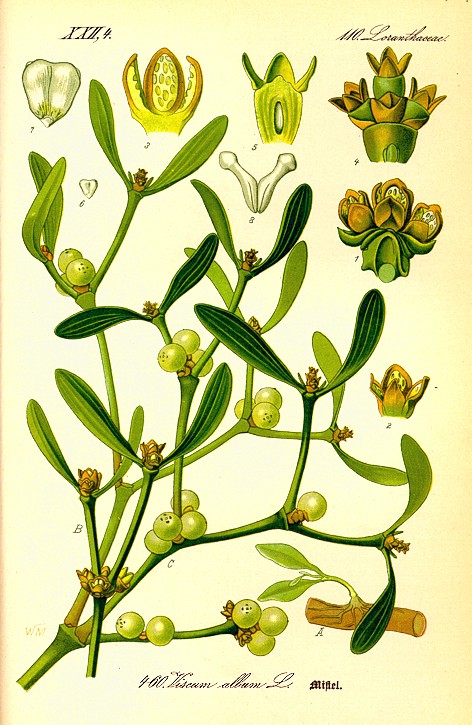
Viscum album - Pianta della famiglia Lorantacee abbastanza comune in Europa e in Asia, sempreverde e semiparassita, il vischio vive sui rami di diverse piante (pino silvestre, pero, melo) e ha l'aspetto di un folto cespuglio con foglie opposte, sessili e oblunghe.
I fiori, unisessuali e giallastri, sono raccolti in fascetti all'ascella delle foglie; il frutto, che matura in inverno, Ŕ una bacca sferica, di colore perlaceo, con polpa gelatinosa contenente un grosso seme.
Nelle credenze e nell'iconografia popolare e religiosa dell'Europa precristiana, il vischio ha sempre occupato un posto di un certo rilievo: ritenuto dotato di poteri magici, veniva un tempo utilizzato per curare la sterilitÓ e come antidoto per svariati veleni. Ancora oggi resistono alcune tradizioni legate al vischio, come la confezione di decorazioni natalizie e lo scambio di un bacio, la notte di Capodanno, sotto un ramo di questa pianta.
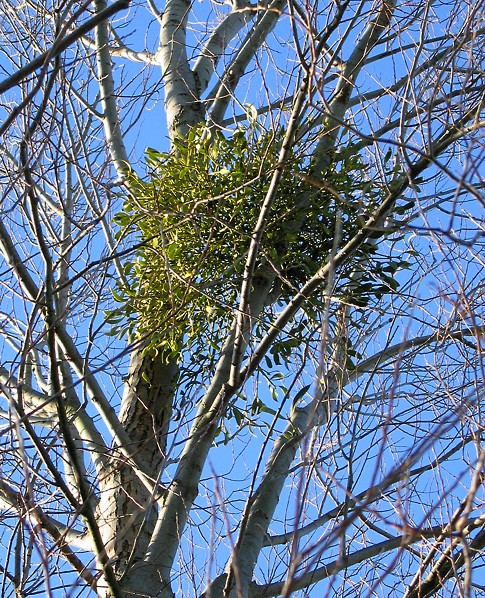
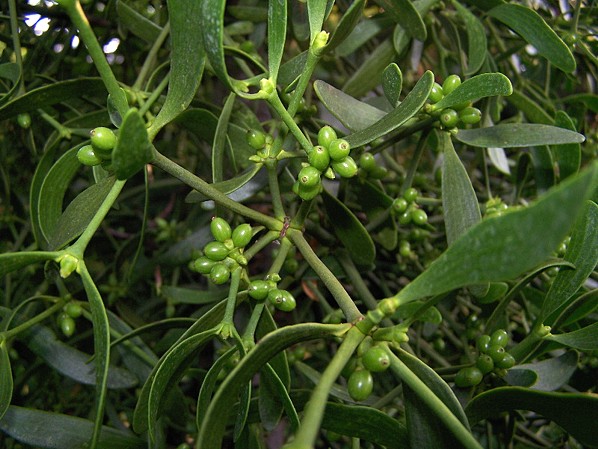
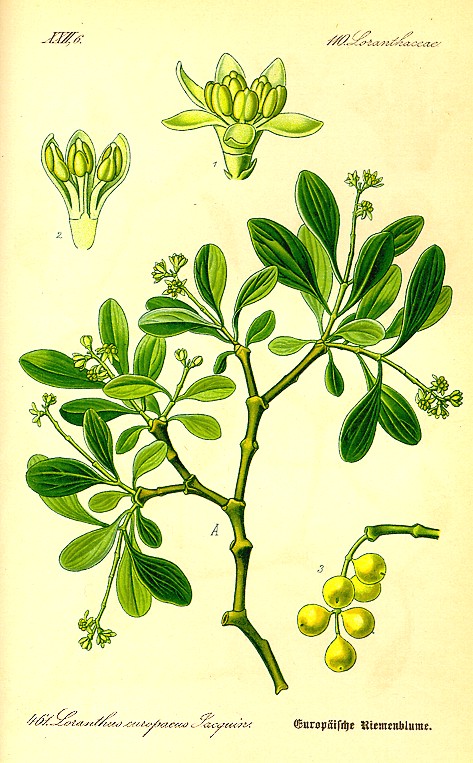
Loranthus europaeus - Vischio quercino - Pianta della famiglia Lorantacee diffusa nell'Europa temperata, parassita di querce, castagni e olivi, su cui forma cespugli ramosissimi dando luogo a un grosso rigonfiamento a cercine nel punto di inserzione sulla pianta ospite. Ha foglie caduche e fiori gialli, regolari; il frutto Ŕ una bacca gialla.
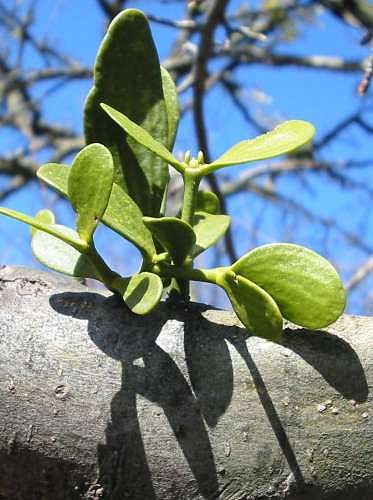
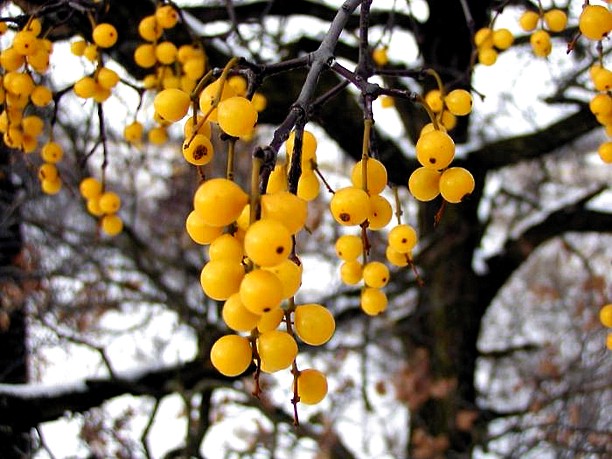
Vischio o Pania
Sostanza
vischiosa e attaccaticcia, estratta dalle bacche del vischio quercino (Loranthus
europaeus) o
prodotta artificialmente, usata per catturare gli uccelli.
Vedi uccellagione![]() .
.
Mistletoe is the common name for a group of hemi-parasitic plants in the order Santalales that grow attached to and within the branches of a tree or shrub. Parasitism evolved only nine times in the plant kingdom; of those, the parasitic mistletoe habit has evolved independently five times: Misodendraceae, Loranthaceae, Santalaceae (formerly considered the separate family Eremolepidaceae), and Santalaceae (formerly treated as the separate family Viscaceae). Although Viscaceae and Eremolepidaceae were placed in a broadly-defined Santalaceae by Angiosperm Phylogeny Group 2, they originated independently, according to DNA sequences analysed by Dan Nickrent, Southern Illinois University.
The word mistletoe is of uncertain etymology; it may be related to
German Mist, for dung and Tang for branch, but Old English
mistel was also used for basil.
Species
The name was originally applied to Viscum album (European Mistletoe, Santalaceae), the only species native in Great Britain and much of Europe. Later it was extended to other related species, including Phoradendron serotinum (the Eastern Mistletoe of eastern North America, also Santalaceae). European Mistletoe is readily recognized by its smooth-edged oval evergreen leaves borne in pairs along the woody stem, and waxy white berries in dense clusters of 2 to 6. In America, the Eastern Mistletoe is similar, but has shorter, broader leaves and longer clusters of 10 or more berries. In the US, Phoradendron flavescens is commercially harvested for Christmas decorations.
The largest family of Mistletoes, Loranthaceae, has 73 genera and over 900 species. Subtropical and tropical climates have markedly more Mistletoe species; Australia has 85, of which 71 are in Loranthaceae, and 14 in Santalaceae.
Life cycle
Mistletoe species grow on a wide range of host trees, and commonly reduce their growth but can kill them with heavy infestation. Viscum album can parasitise more than 200 tree and shrub species. Almost all mistletoes are hemi-parasites, bearing evergreen leaves that do some photosynthesis, and using the host mainly for water and mineral nutrients. An exception is the leafless quintral, Tristerix aphyllus, which lives deep inside the sugar-transporting tissue of a spiny cactus, appearing only to show its tubular red flowers. The genus Arceuthobium (dwarf mistletoe; Santalaceae) has reduced photosynthesis; as an adult, it manufactures only a small proportion of the sugars it needs from its own photosythesis but as a seedling it actively photosynthesizes until a connection to the host is established.
Some species of the largest family, Loranthaceae, have small, insect-pollinated flowers (as with Santalaceae), but others have spectacularly showy, large, bird-pollinated flowers. Most mistletoe seeds are spread by birds, such as the Mistle Thrush in Europe, the Phainopepla in southwestern North America, and Dicaeum of Asia and Australia; they derive sustenance through eating the fruits (drupes). The seeds are excreted in their droppings and stick to twigs, or more commonly the bird grips the fruit in its bill, squeezes the sticky coated seed out to the side, and then wipes its bill clean on a suitable branch. The seeds are coated with a sticky material called viscin (containing both cellulosic strands and mucopolysaccharides), which hardens and attaches the seed firmly to its future host.
Ecological importance
Mistletoe was often considered a pest that kills trees and devalues natural habitats, but was recently recognized as an ecological keystone species, an organism that has a disproportionately pervasive influence over its community. A broad array of animals depend on mistletoe for food, consuming the leaves and young shoots, transferring pollen between plants, and dispersing the sticky seeds. The dense evergreen witches' brooms formed by the dwarf mistletoes (Arceuthobium species) of western North America also make excellent locations for roosting and nesting of the Northern Spotted Owls and the Marbled Murrelets. In Australia the Diamond Firetails and Painted Honeyeaters are recorded as nesting in different mistletoes. This behavior is probably far more widespread than currently recognized; more than 240 species of birds that nest in foliage in Australia have been recorded nesting in mistletoe, representing more than 75% of the resident avifauna.
A study of mistletoe in junipers concluded that more juniper berries sprout in stands where mistletoe is present, as the mistletoe attracts berry-eating birds which also eat juniper berries; juniper berries that have passed through a bird's digestive tract are less likely to remain imprisoned within a hardened outer capsule. Such interactions lead to dramatic influences on diversity, as areas with greater mistletoe densities support higher diversities of animals. Thus, rather than being a pest, mistletoe can have a positive effects on biodiversity, providing high quality food and habitat for a broad range of animals in forests and woodlands worldwide.
In culture and mythology
European mistletoe, Viscum album, figured prominently in Greek mythology, and is believed to be The Golden Bough of Aeneas, ancestor of the Romans. The Norse god Baldur was killed with a spear made of mistletoe.
Mistletoe bears fruit at the time of the Winter Solstice, the birth of the new year, and may have been used in solstitial rites in Druidic Britain as a symbol of immortality. In Celtic mythology and in druid rituals, it was considered an antidote to poison, although the fruits of many mistletoes are actually poisonous if ingested as they contain viscotoxins.
An old Christian tradition said that mistletoe was once a tree and furnished the wood of the Cross. After the Crucifixion, the plant shriveled and became dwarfed to a parasitic vine.
In Romanian traditions, mistletoe is considered a source of good fortune. The medical and the supposed magical properties of the plant are still used, especially in rural areas.
A popular myth says that the Mistletoe was cut with a gold sickle and it lost its power if it fell and touched the ground. This is a confusion with the Holly 'holy' Tree, the most sacred tree of the druids (after the Oak) due to both plants being green all year, having colorful fruits and sharing similar history of winter months. Getafix, the druid in the Asterix comics, was often seen up trees collecting Mistletoe, and it was alluded to be an ingredient in his magic potion.
Mistletoe has sometimes been nicknamed the vampire plant because it can probe beneath the tree bark to drain water and minerals, enabling it to survive during a drought. William Shakespeare gives it an unflattering reference in Titus Andronicus, Act II, Scene I: "Overcome with moss and baleful mistletoe".
Mistletoe is commonly used as a Christmas decoration, though such use was rarely alluded to into the 18th century. Viscum album is used in Europe whereas Phoradendron serotinum is used in North America. According to custom, the mistletoe must not touch the ground between its cutting and its removal as the last of Christmas greens at Candlemas; it may remain hung through the year, often to preserve the house from lightning or fire, until it was replaced the following Christmas Eve. The tradition has spread throughout the English-speaking world but is largely unknown in the rest of Europe. The appearance and nature of the fruit's content (viscin) is very similar or suggestive of human semen and this has strengthened its pagan connections.
Mistletoe (Phoradendron flavescens) is the state floral emblem for the State of Oklahoma. The state did not have an official flower, leaving the Mistletoe as the assumed state flower until the Oklahoma Rose was designated as such in 2004.
Kissing under mistletoe at Christmas
According to a custom of Christmas cheer, any two people who meet under a hanging of mistletoe are obliged to kiss. The custom is Scandinavian in origin.
The custom has been incorporated into various holiday songs. The 1943 song I'll Be Home for Christmas tells the story of a lonely traveler looking forward to coming home and seeing, among other things, mistletoe. The Mistletoe is mentioned in the song "Chestnuts roasting on an open fire" ("The Christmas Song"), made famous by Nat King Cole, and written by Mel Torme. The song "A Holly Jolly Christmas" sung by Burl Ives, and used for the TV special "Rudolph the Red Nosed Reindeer", features the line, "Ho Ho, the Mistletoe", and the line, "Kiss her once for me". In 1961 singer Aretha Franklin released a Christmas song called Kissin' by the Mistletoe. In 1971 singer Lynn Anderson recorded the song Mr. Mistletoe on her holiday album The Christmas Album. The song talks about an elf who hangs mistletoe in homes so that people can "steal a kiss from someone that they know". In 2001 Barbra Streisand released the song It Must Have Been the Mistletoe. Rocking around the Christmas Tree also refers to "mistletoe hung where you can see, every couple tries to stop". A popular child's Christmas song's first line is, "I saw Mommy kissing Santa Claus, underneath the mistletoe last night."
Other uses
Mistletoe leaves and young twigs are used by herbalists, and it is popular in Europe, especially in Germany, for treating circulatory and respiratory system problems, and cancer.. Mistletoe is being studied as a potential treatment for tumors. Although such use is not yet permitted in the US, mistletoe is prescribed in Europe. The sticky juice of mistletoe berries was used as adhesive to trap small animals or birds.